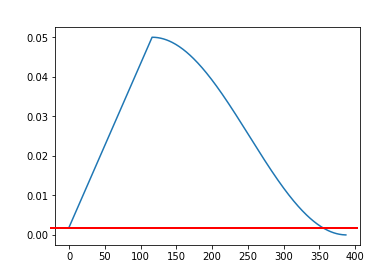I think the explanation for this is that the optimizer resets, and it’s using momentum, so by the end of the previous training it had a better “idea” of which direction to head, whereas when you restart it starts off by heading in a less optimal direction.
No, absolutely not.
The cycle of one cycle follows this structure. The cycle length of the total move up and down is accros the number of epochs. So if you do one epoch and then run it again, it will do the “triangle” twice. @edwardjross, this also explains why the learning rate at the beginning is higher than at the end of the previous cycle!

Sorry, @sandmann, answered somehow to the wrong question, this was in answer to you.
Also, for metrics, instead of error rate can use F1 score instead of error rate… as @wdhorton mentioned, sampling should be done, based on the class distribution
Never thought like that simple equation y = mx + c can be written as matrix dot product.
not only the momentum, but also the LR itself!
Sorry I meant underfitting I just made a mistake about the losses. Sorry, morning with no coffee over here.
Question: Image size, size parameter in ImageDataBunch, that is set to 224. Is it better that is you will get lower error when images are higher resolution (it will take more time, bs smaller)? or the image resolution need to be 224 for resnet34?
is there a no.of.epochs learner like lr learner?
For imbalanced classes question: would you balance you validation set or check on unbalanced validation set?
Jeremy’s answer on handling unbalanced data eg 200 real bears and 50 teddy bears “just try it, it always just works fine”… is that only when starting with a well-trained net, or is also when starting fresh?
If consciousness arrises from complex enough data processing, at what point do you give up on ML training and obsess over AI sentience?
The model isn’t evenly trained. There’s the resnet backbone, which has been extensively trained on all of Imagenet, and the head, which we add on for our classification purpose and is entirely untrained.
If you trained the entire model at once, you could get large errors coming from the untrained layers back propagating through the model and messing up your nicely pretrained weights.
Training with the backbone frozen allows us to only trained the untrained layers in the head. Once those layers have converged somewhat, we unfreeze the entire model and continue training.
Its OK. I just saw what you meant. It was good question.
“The cycle length of the total move up and down is accros the number of epochs.”
Thanks a lot - that’s important to understand!
When you first access models.resnet34 you get a progress bar while it downloads the model to disk, which is the thing that confused me.
if you dont get that url download file after below, check the adblocker.
urls = Array.from(document.querySelectorAll(’.rg_di .rg_meta’)).map(el=>JSON.parse(el.textContent).ou);
window.open(‘data:text/csv;charset=utf-8,’ + escape(urls.join(’\n’)));
That’s the pretrained models. Here during inference, you’ll load your own model.
learn.be_patient()
I am interested, what is the right practice in fastiai, to load a set videos and sample e.g. every 3 second, to from a bunch series of images. So that I can apply Resnet34 (time-distributed) on each image and apply an LSTM on the next layer, for building a video classifier?
For unbalanced data: What do you do if the class you care most about is a rare class. An example is identifying skin lesions where the most common benign class is way more frequent than melanoma?